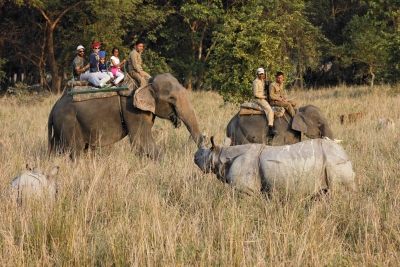
One of the densest habitats of the greater one-horned rhinoceros in the world, Pobitora Wildlife Sanctuary spans about 40 sq.km. in Assam. It was declared a reserve forest in 1971 and a wildlife sanctuary 10 years later. The humid grasslands, along with woodlands and wetlands, make the region a perfect place for not just the one-homed rhino but several other birds and animals. The annual flooding of the Brahmaputra in the Sanctuary both clears unwanted waste and rejuvenates the vegetation there. However, its increasing severity of late has caused more damage than it has left room for regeneration. Likewise, the annual seasonal burning of grasslands have been crucial for the growth of new vegetation, but with a lack of proper monitoring this too is said to have been causing more damage than helping the habitat and its inhabitants.
Wildlife
Kites, eagles, vultures, harriers, kingfishers, geese, ducks, egrets, grebes, cormorants, pelicans, herons, darters, storks, doves, coucals, lapwings, bittens, treepies, orioles, shrikes, leafbirds, jacanas, shovelers, teals, coots, moorhens, sandpipers, greenshanks, terns, nightjars, swifts, starlings, and munias are among the several species of migrant and resident birds that can be spotted in the region. In addition to the one-homed rhinoceros, one can also spot leopards, wild boars, barking deer, wild buffaloes, leopard cats, fishing cats, jungle cats, jackals and Chinese pangolins in the Sanctuary. The place is also home to a large number of amphibian, reptile and fish species.
Migrating birds
In addition to its famed pachyderm, the Sanctuary is also noted for its migratory birds. Every winter, the region welcomes thousands of these winged visitors. As with many places, some years are good and some, not so. For instance, in 2012, at least 20,000 birds visited the Sanctuary while in 2015, the numbers were said to have come down.
The problem of plenty
As mentioned earlier, Pobitora has a high density of rhinos – about a hundred of them occupying the core areas of the Sanctuary. While the growing number of rhinos is certainly good news, all of them having to rub shoulders within a small space is not good at all. For one, the risk of spreading infection or disease within a group increases substantially, and could lead to mass deaths of the animals in just one big swipe. Also, they jostle for not just space but food too. This could lead to many of them straying into human habitation, resulting in tragedy on both sides. The gravest concern in the crowded region is how vulnerable these creatures are to poaching.
Poaching
While poaching is a near-universal problem, Pobitora faces a unique problem – floods. When the Sanctuary is flooded annually by the swelling Brahmaputra, it could lead to loss of animal life in many ways. The animal could face a watery grave, stray from its habitat and be injured on roads or be caught in a conflict with humans, or worse, be trapped by a poacher. Most parts of the Sanctuary remain inaccessible due to the floods, an opportunity poachers make best use of. This problem is being handled by placing frontline forest staff on 24×7 duty, as was evident this July, after the floods.
Picture Credit : Google
